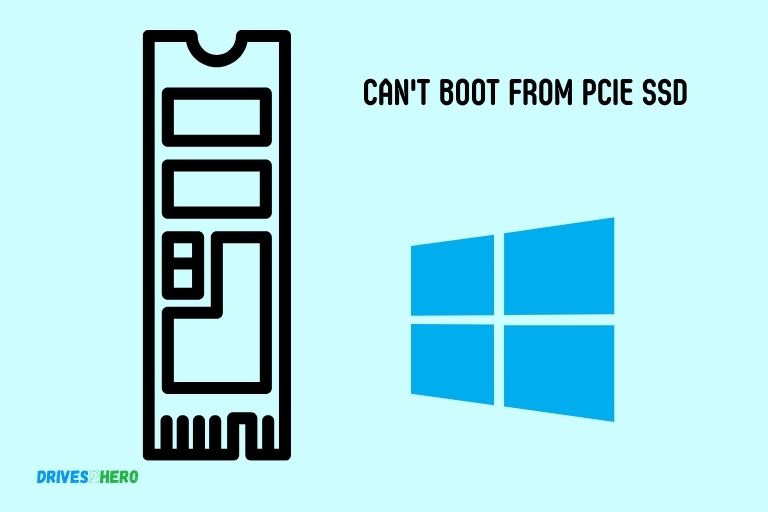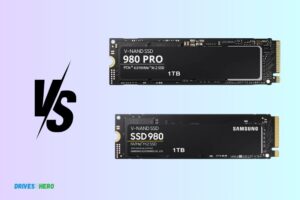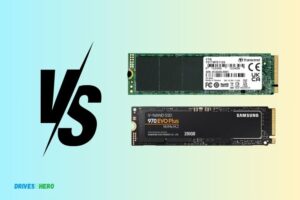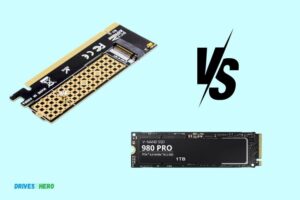Can’t Boot from Pcie SSD? 11 Steps!
It is possible to boot from a PCIe SSD (Solid State Drive); however, the inability to do so may be due to several reasons such as outdated BIOS (Basic Input Output System), incompatible motherboard, or incorrect boot order settings.
Booting from a PCIe SSD requires specific support from both your motherboard and your system’s BIOS. If these components are outdated or incompatible, booting may not be achievable.
You may also experience booting issues if your system’s boot order is not correctly configured to prioritize the SSD.
However, challenges may arise, typically stemming from BIOS settings, compatibility issues with the motherboard, or the system’s boot order. Therefore, addressing these factors may resolve the booting issue with your PCIe SSD.

11 Steps To Boot from PCIe SSD
| Troubleshooting Steps | Description |
|---|---|
| Check BIOS/UEFI Settings | Ensure that your motherboard’s BIOS/UEFI settings are configured to boot from the PCIe SSD. Check the boot order and select the SSD as the primary boot device. |
| Verify PCIe Slot Compatibility | Ensure that your PCIe SSD is installed in a compatible slot on the motherboard. Some slots may not support booting. Refer to your motherboard’s manual. |
| Secure Connection | Check that the PCIe SSD is securely seated in the slot. Loose connections can prevent the SSD from being recognized during boot. |
| Ensure OS Installation | Confirm that your operating system is correctly installed on the PCIe SSD. Reinstall the OS if necessary, making sure to select the SSD as the installation destination. |
| Update SSD Firmware | Check if there are any firmware updates available for your PCIe SSD. Updating the firmware can resolve compatibility issues. |
| Bootable OS Media | Create a bootable USB drive with your OS and use it to boot the system. From there, you can attempt to repair or reinstall the OS on the SSD. |
| Legacy/UEFI Compatibility | Ensure that the system is set to use the correct boot mode (Legacy or UEFI) that matches your OS and motherboard settings. Mismatch can cause boot issues. |
| Check for BIOS/UEFI Updates | Visit your motherboard manufacturer’s website and check for BIOS/UEFI updates that might address compatibility issues with PCIe SSDs. |
| Test in Another System | If possible, test the PCIe SSD in another computer to determine if the issue is with the SSD or the motherboard. |
| Inspect for Hardware Failures | Check for physical damage on the SSD, motherboard, or other components. Faulty hardware can cause boot problems. |
| Seek Professional Assistance | If troubleshooting does not resolve the issue, consider seeking assistance from a computer technician or the SSD/motherboard manufacturer’s support. |
Key Takeaway
Why Can’t Boot From Pcie Ssd
Find out what could be preventing your system from recognizing the PCIe SSD as a bootable device and how to resolve this problem effectively.
Common Issues Causing Inability To Boot From Pcie Ssd:
There can be several reasons why you might be unable to boot from your PCIe SSD.
Let’s explore some common issues causing this problem:
- Incompatible motherboard firmware: Some older motherboards may not have the necessary firmware updates to support booting from PCIe SSDs. Check your motherboard manufacturer’s website for any available updates.
- Incorrect BIOS settings: Incorrect BIOS settings can prevent your system from recognizing and booting from the PCIe SSD. Ensure that the SSD is properly set as the primary boot device in the BIOS settings.
- UEFI boot mode: PCIe SSDs require UEFI boot mode for proper functioning. If your system is set to Legacy Boot mode, it may not be able to boot from the SSD. Change your boot mode to UEFI in the BIOS settings.
- Secure Boot restrictions: Secure Boot, a feature designed to protect against unauthorized access, can sometimes cause issues with booting from PCIe SSDs. Check if disabling Secure Boot allows your system to boot from the SSD.
- Driver issues: Outdated or incompatible drivers can hinder the booting process. Make sure you have the latest drivers installed for your motherboard and PCIe SSD.
- Faulty hardware connection: A loose or faulty connection between the PCIe slot, SSD, and motherboard can prevent proper booting. Ensure that all connections are secure and functioning correctly.
By systematically addressing these potential barriers, you can increase your chances of successfully booting from your PCIe SSD.
Bios Settings
BIOS settings may prevent booting from a PCIe SSD, causing startup issues. Ensure the correct configuration for successful booting and optimal performance.
Let’s explore the key settings to check:
Ensure PCIe Gen Mode: Check if your BIOS has an option to select the PCIe generation mode. Make sure it is set to the appropriate PCIe generation supported by your SSD and motherboard, such as PCIe Gen3 or PCIe Gen4.
Using an incorrect PCIe generation mode can result in compatibility issues and prevent your PCIe SSD from booting.
Enable UEFI Boot: Confirm that your BIOS is set to boot using the Unified Extensible Firmware Interface (UEFI) rather than the legacy BIOS mode.
UEFI offers improved support for modern hardware, including PCIe SSDs. Enable UEFI boot and disable legacy boot options if necessary.
Check Boot Order: Verify that the PCIe SSD is correctly listed in the boot order. It should be prioritized over other boot devices, such as traditional hard drives or USB devices. Adjust the boot order if needed to ensure the computer attempts to boot from the PCIe SSD first.
Disable Secure Boot: Some systems have a Secure Boot feature that only allows booting from digitally signed operating systems. If your PCIe SSD does not have a signed bootloader, you may need to disable Secure Boot in the BIOS settings.
Update BIOS Firmware: Outdated BIOS firmware can cause compatibility issues when booting from a PCIe SSD. Check the manufacturer’s website for any available BIOS updates and follow their instructions to install the latest version.
Remember to consult your motherboard’s user manual or the manufacturer’s documentation for specific instructions related to your system.
Hardware Compatibility
When it comes to booting from a PCIe SSD, ensuring hardware compatibility between the motherboard and SSD is crucial.
Here’s what you need to know:
- Check the PCIe Slot Version: Ensure that your motherboard has a compatible PCIe slot version. The most common ones are PCIe 3.0 and PCIe 4.0. Refer to your motherboard’s specifications to confirm its compatibility with your PCIe SSD.
- Consider the Form Factor: PCIe SSDs come in different form factors, such as M.2 or U.2. It’s important to check if your motherboard has the corresponding slot for the SSD form factor you are using.
- Verify the Interface Type: PCIe SSDs can use different interfaces like NVMe (Non-Volatile Memory Express) or AHCI (Advanced Host Controller Interface). Check the interface type supported by your motherboard and ensure it matches your SSD.
- Check for BIOS/UEFI Support: Verify that your motherboard’s BIOS or UEFI firmware supports booting from a PCIe SSD. Some older motherboards may lack this support or require a BIOS/UEFI update to enable it.
- Power Limitations: Consider the power requirements of the PCIe SSD and ensure that your motherboard can provide the necessary power. PCIe SSDs may require additional power connectors or draw power directly from the PCIe slot.
- Updated Motherboard Firmware: Keeping your motherboard’s firmware up to date ensures compatibility with the latest hardware, including PCIe SSDs. Check the manufacturer’s website for any available updates.
Verifying compatibility between your motherboard and PCIe SSD is crucial for successful booting.
Secure Boot
Secure Boot can sometimes prevent the system from recognizing the SSD as a valid boot device. Make sure to check your system’s Secure Boot settings and disable it if necessary to resolve the issue.
Can’t Boot From Pcie Ssd:
If you’re experiencing issues booting from your PCIe SSD, one possible culprit could be the Secure Boot feature in your system.
Secure Boot is a security standard that ensures only digitally signed and trusted operating systems are loaded during the boot process.
While this feature provides an added layer of protection against unauthorized software, it may also interfere with the booting process of certain PCIe SSDs.
Disabling Secure Boot If Causing Issues
To troubleshoot this problem, you can try disabling Secure Boot temporarily.
Here are the steps to do it:
- Access the BIOS/UEFI settings on your computer by pressing the designated key during startup (usually Del, F2, or F10).
- Navigate to the Security or Boot section, depending on your system.
- Look for the Secure Boot option and set it to Disabled.
- Save the changes and exit the BIOS/UEFI settings.
- Restart your computer and check if the PCIe SSD boots successfully.
Remember, Secure Boot is designed to protect your system from unauthorized software, so it’s advisable to enable it once you have resolved the booting problem.
Legacy Boot Support
Legacy Boot Support is essential for those experiencing issues booting from PCIe SSD. This feature allows for compatibility with older systems and ensures seamless startup from the SSD.
Enabling For Older Motherboards:
If you’re experiencing difficulties booting from a PCIe SSD on an older motherboard, it could be due to a lack of legacy boot support.
Legacy boot support allows the motherboard to recognize and boot from devices using older firmware interfaces, such as BIOS.
Here’s how you can enable legacy boot support to solve this issue:
- Check your motherboard’s user manual: Before attempting any changes, consult the user manual of your motherboard to ensure it supports legacy boot. Look for specific instructions or BIOS settings related to legacy boot.
- Access the BIOS settings: Restart your computer and access the BIOS settings by pressing the designated key during startup. The key to access the BIOS varies depending on the manufacturer and motherboard model. Common keys include F2, F10, and DEL.
- Locate the boot options: Once in the BIOS settings, navigate to the boot options menu. This menu may be labeled differently depending on the motherboard, but it usually contains terms such as “Boot,” “Boot Options,” or “Boot Priority.”
- Enable legacy boot: Within the boot options menu, search for an option related to legacy boot or compatibility support module (CSM). Enable this option to activate legacy boot support on your motherboard.
- Save and exit: After enabling legacy boot, save the changes you made in the BIOS settings and exit the menu. Your computer will now restart, and the changes will take effect.
- Verify boot from PCIe SSD: Once your computer restarts, attempt to boot from the PCIe SSD again. Check if the issue has been resolved and your system can successfully boot from the SSD.
By following these steps, you can ensure that your motherboard recognizes and boots from the PCIe SSD, allowing you to take full advantage of its speed and performance.
Driver Installation
Having trouble booting from your PCIe SSD? Ensure that the driver installation is properly done to overcome this issue efficiently. Get your system up and running smoothly with the right driver installation for your PCIe SSD.
Installing The Appropriate Drivers For The Pcie Ssd
Once you’ve installed your PCIe SSD, it’s crucial to ensure that the correct drivers are installed for smooth functioning and optimal performance.
The driver installation process can vary depending on your operating system, so let’s dive into some essential information and steps to guide you through the process.
Windows Os Installation:
To install the appropriate drivers for your PCIe SSD on a Windows operating system, follow these steps:
- Open your preferred web browser and navigate to the manufacturer’s website.
- Locate the “Support” or “Downloads” section of the website.
- Enter the model number or name of your PCIe SSD to find the relevant drivers.
- Download the latest driver version compatible with your Windows OS.
- Once the driver is downloaded, locate the file and double-click to initiate the installation process.
- Follow the on-screen instructions provided by the installer.
- After the installation is complete, restart your computer to ensure the changes take effect.
Reinstalling Windows
Reinstall Windows easily without booting issues from your PCIe SSD with these simple steps. Fix the problem and get your PC up and running smoothly again.
If you’re facing issues with booting from your PCIe SSD, reinstalling Windows may be the solution. Proper driver installation ensures that your system recognizes and utilizes the PCIe SSD effectively.
Here’s a step-by-step guide to reinstalling Windows and resolving the booting problem:
Check System Requirements Before Proceeding:
- Ensure that your system meets the minimum requirements for the version of Windows you plan to install.
- Verify if your motherboard supports booting from a PCIe SSD.
Create A Windows Installation Media:
- Download the Windows ISO file or create a bootable USB drive using the Media Creation Tool.
- Follow the instructions provided by Microsoft to create the installation media.
Backup Your Data:
- Before reinstalling Windows, it’s essential to back up all your important files and folders to ensure you don’t lose any data.
Access The Bios Settings:
- Restart your computer and enter the BIOS settings by pressing the designated key during boot (usually F2, F10, or Del).
- Locate the boot options and change the boot order to prioritize the PCIe SSD as the primary boot device.
Install Windows:
- Insert the Windows installation media (USB drive or DVD) into your computer.
- Restart your system and follow the on-screen instructions to begin the installation process.
- When prompted, choose the custom installation option to ensure a fresh installation.
- Select the PCIe SSD as the destination drive for the Windows installation.
- Complete the installation process by following the instructions provided by the Windows installer.
Install Drivers And Updates:
- After reinstalling Windows, it’s crucial to install the necessary drivers to ensure proper functionality of your hardware components.
- Visit the manufacturer’s website and download the latest drivers for your motherboard, including any drivers specific to the PCIe SSD.
- Install all available Windows updates to ensure your system is up to date.
What Steps Can I Take to Boot from Pcie SSD if I’m Having Issues?
If you are encountering problems while trying to boot from a PCIe SSD, there are a few steps you can take. Firstly, access your computer’s BIOS settings and enable PCIe SSD in BIOS. Restart your system and check if the SSD is recognized. Ensure that the SSD is properly connected and has the required power supply. Lastly, update your BIOS firmware and check for any specific instructions provided by the SSD manufacturer.
Partitioning And Formatting
Partitioning and formatting your PCIe SSD correctly is crucial to ensure that your system can boot from it seamlessly.
Properly configuring the partition and format settings can help overcome the issue of not being able to boot from your PCIe SSD.
The Ssd Correctly
Partitioning and formatting your PCIe SSD correctly is crucial to ensure that it can be properly recognized and bootable. Here are the essential steps to follow:
Partitioning the SSD:
- Open the Disk Management tool by right-clicking the Start button and selecting “Disk Management.”
- Locate your PCIe SSD in the list of drives and right-click on it.
- Choose the “New Simple Volume” option and follow the prompts to create a new partition.
- Specify the desired size for the partition and assign a drive letter.
- Format the partition using the NTFS file system.
Formatting the SSD:
- Right-click on the newly created partition and choose the “Format” option.
- Select the desired file system (NTFS is recommended for Windows) and provide a volume label.
- You can also choose to perform a quick format if you don’t need to scan for bad sectors.
- Click on the “OK” button to start the formatting process.
Verifying the SSD:
- Open File Explorer and check if the newly formatted SSD partition appears.
- Ensure that the partition is accessible and ready to be used.
- If necessary, assign a drive letter to the partition by right-clicking on it and selecting “Change Drive Letter and Paths.”
Properly partitioning and formatting your PCIe SSD ensures that it is set up correctly for booting. By following these steps, you can ensure that your SSD is correctly recognized and ready to use.
Conclusion
The inability to boot from a PCIe SSD can be a frustrating issue for many users. However, it is important to first ensure that the necessary hardware and software configurations are in place.
By checking the motherboard compatibility, updating the BIOS, and adjusting the boot settings, you can increase the chances of successfully booting from a PCIe SSD.
It is also worth considering the option of using an alternative boot device or seeking professional assistance if needed.
Understanding the potential causes and solutions for this problem is crucial in order to make the most out of your PCIe SSD and enjoy its benefits.






